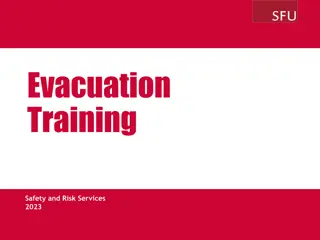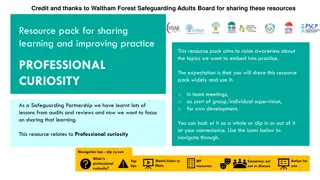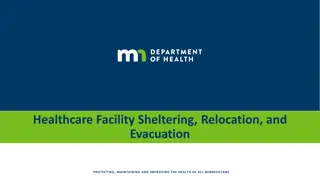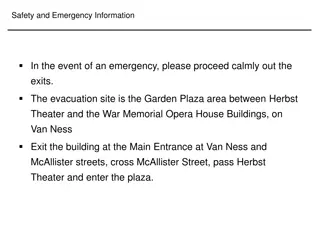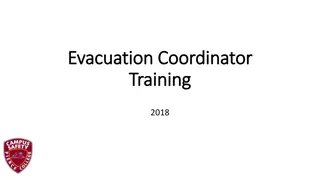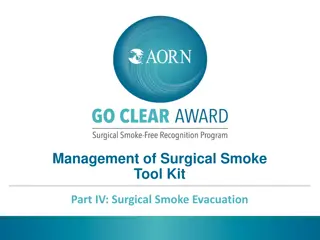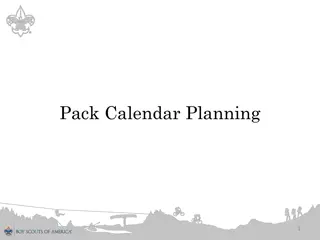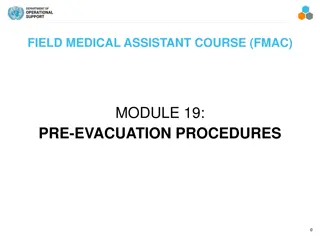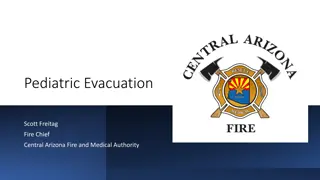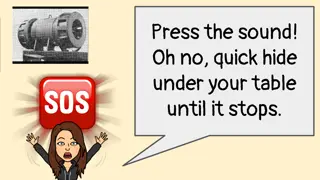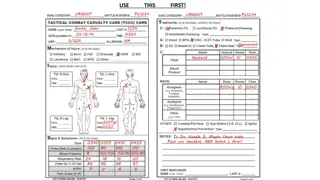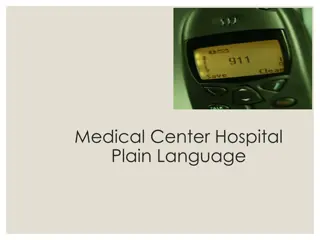Being Prepared for Evacuation: What to Pack in a Hurry
In times of emergency evacuations, it's crucial to have a grab-and-go kit ready. This article highlights the importance of being prepared for evacuation situations, providing insights on what essential items to take when evacuating your home swiftly. Real-life experiences and guidance from FEMA underscore the significance of planning ahead for such scenarios to ensure safety and essential needs are met efficiently.
Download Presentation

Please find below an Image/Link to download the presentation.
The content on the website is provided AS IS for your information and personal use only. It may not be sold, licensed, or shared on other websites without obtaining consent from the author. Download presentation by click this link. If you encounter any issues during the download, it is possible that the publisher has removed the file from their server.
E N D
Presentation Transcript
Saginaw County ARES Saginaw County ARES
What If You Had To Evacuate Your Home In A Hurry? What would you take? (Evacuation Grab and Go Kit) What If You Had To Evacuate Your Home In A Hurry? What would you take? (Evacuation Grab and Go Kit)
Many of us have assembled go kits for our radio equipment and other items we would use to serve others in an emergency situation. But how many of us have put together a list of item we would take if we had to evacuate our home or apartment. Particularly if it were possible our home or apartment may not survive the disaster for which we are being evacuated.
What if there was a disaster such as a fire, hazardous chemical release, nuclear disaster, etc. that required you to evacuate. If you only had 5 minutes, 30 minutes, or even 1 hour to evacuate, what would you take? How do you prepare a list of those items?
A few weeks ago, a fire sparked on a tiny trail on the foothills of the Santa Ana Mountains in Anaheim, California. It moved fast, and through news reports, we watched it snake its way toward our sleepy, suburban neighborhood. By evening, there were mandatory evacuations about half a mile away from us. It took me and my husband two hours to get home from work due to the road closures, and once there, we needed to evacuate, too. (Luckily, my two kids were with my mother, away from the fire.) I rushed around grabbing valuables and clothing. But then I froze. I had no idea what I was supposed to pack. Sentimental photos? Artwork? I looked around my home and wondered what I could afford to lose. A neighbor reminded me to pack our important papers, and I remembered to wear the antique jewelry my grandmother left me. But I was so panicked that all I ended up with were suitcases full of ill-fitting clothes, passports and paintings. (To my credit, I did not forget to pack the cat.)
According to FEMA, evacuations are pretty common in the United States. Aside from natural disasters such as fires, earthquakes and hurricanes, people are often told to leave their homes due to transportation and industrial accidents.
Think about the following four questions when preparing your list: What would you need to start over if everything was destroyed? What would you need to survive a few days or a week? What is important to you? What can you fit in your evacuation vehicle?
If you are like most people your list will be random at first and ideas will continue to pop into your head for days. Get you family together and brain storm. Just writing down what comes to mind. Involve your children, they may think of things you don t and they will come up with things that are essential to them (particularly if they are young) which you may leave off the list. Later you will organize and prioritize the list.
List the items that are essential then those that are important. It is recommend to break the list into four groups: 5min 30min 2hrs 12hrs evacuation Essential items go into the 5 min evacuation time list. As you refine your list, items may move from one list to another. An item should only appear on one list. If you have time, you move from one list to the next.
As you finalize the list, indicate where each item is located. You will likely figure out ways to simplify you task by putting things together or over time put items such as photos, documents, etc. on a disk, USB external hard drive, or flash drives. If possible have a copy of these documents stored in a location out of your geographical area, say with a family member or relative. This will save on what you have to pull together. It is highly recommend that you keep copies or scans of essential documents on a flash drive that is in a water proof container and is easy to grab.
Determine what you can actually fit in your vehicle and refine your list. Post your list on the back or your pantry door. You may want to give a copy of the list to a neighbor so they could grab the essential items if you are not at home when the evacuation takes place. Plan the list with or without the aid of anyone else. You may have family members at home to help you or you may be alone.
Choose a bag. Each member of the family should have his or her own evacuation bag. Start with a backpack or a similar item to fit your items into. Take photos of all the rooms in your home, along with all your valuables. photos on a cloud server, and back them up on a flash drive. Choose a bag. Take photos of all the rooms in your home, along with all your valuables. Store these
Scan all your important documents, and save them on a flash drive. them onto a cloud server if you have an encryption service you trust. Scan all your important documents, and save them on a flash drive. You could also save
Wallet or purse Driver s license Proof of insurance Car/house keys Cell phone, charger & car charger Adequate clothing for the weather conditions Prescriptions Extra contacts or glasses Medical devices (wheel chair, hearing aid, retainer, etc.) Laptop or backup disks Computer CPU 72 Hour kit with water/food/clothes/toiletries/ Family photo CD's/money, etc. Baby bag with extra food/formula
Important documents (should already be in one container) The deed to your house Your will and/or trust Medical records Passports Social security cards Birth certificates A list of personal contacts with their addresses and phone numbers Your kids immunization records Your pet s paperwork for vaccinations and medical history Pet food, water & dish Pet leash (need this to walk dog or for shelters) Pet carrier
Photo albums, family portraits, preferably on flash drive Case of bottled water Additional Non-perishable food Sleeping bags, blankets, pillows, towels. Tent Extra batteries Battery powered TV/radio More clothes Toys, activities to keep kids occupied Kids memory things
First-aid kit (in your evac vehicle?) Flashlight, batteries (in your evac vehicle?) What else would you take?
What else would you take if you had 2 hours to prepare?
We have seen and heard of disasters in other areas of the country over the last several weeks which should make the usefulness of this guidance clear. I bet many wished they had put together such a plan before hand so Be Prepared.
Decide on what you need to have. Keep your evacuation lists handy. Have a copy of important documents, photos, etc. on a disk, USB external hard drive, or flash drives and have a copy stored in a location out of your geographical area. Practice your evacuation ahead of time so it will be easier and less stressful.
https://www.ready.gov/evacuation https://simplefamilypreparedness.com/woul d-you-be-ready/ https://www.iii.org/article/preparing- effective-evacuation-plan http://www.disasterkitplanner.com/
harriscountyares.org RedCross FEMA Lilledeshan Bose lifehacker.com

 undefined
undefined





